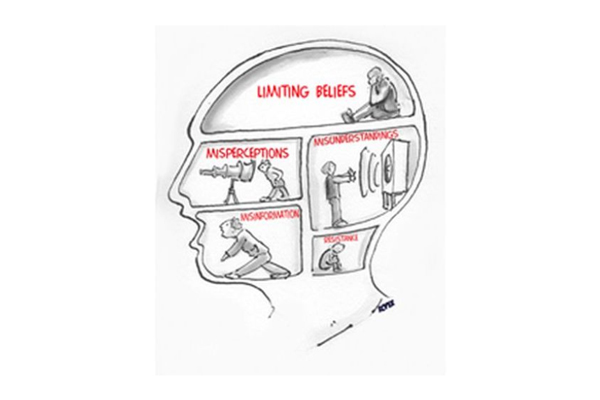Nine times out of ten, it’s not the market, resources, or competition – it’s the stories you’re telling yourself. Limiting beliefs are silent saboteurs: they shape your organisation’s culture, decisions, and outcomes in ways you might not even realise.
Great leaders don’t just challenge these beliefs; they rewrite them. And the good news is, you can too.
What are limiting beliefs?
Limiting beliefs are the invisible rules that shape what your organisation sees as possible. They’re often passed off as truths but are really just assumptions, like:
- “This is how it’s always been done.”
- “We can’t compete with bigger players.”
- “Recessions mean poor sales.”
They feel safe, but safety doesn’t breed success. Over time, these beliefs become cultural blocks, quietly eroding innovation, team morale, and even your bottom line.
Famous (and flawed) limiting beliefs
History is full of people who underestimated possibility. Here are a few examples:
- “I think there’s a world market for maybe five computers.” – Thomas Watson, IBM Chairman, 1943
- “There’s no reason anyone would want a computer in their home.” – Ken Olson, Founder of Digital Equipment Corp, 1977
- “Heavier-than-air flying machines are impossible.” – Lord Kelvin, Royal Society President, 1895
- “We don’t like their sound, and guitar music is on the way out.” – Decca Records rejecting The Beatles, 1962
Imagine if these beliefs had stuck! Now, think about what beliefs are quietly holding your business back.
The leader’s role in creating a ‘can-do’ culture
Culture starts at the top, and a can-do culture can only thrive under leaders who’ve tackled their own limiting beliefs. Here’s how:
Work on yourself first
- Limiting beliefs aren’t just an organisational problem—they’re a personal one. Before you can coach your team, you need to uncover and challenge your own blocks.
- What’s your inner narrative saying about your capabilities?
- Do you ever find yourself saying, “I can’t manage that” or “That’s not realistic”?
A trained coach can help you unpick these patterns and replace them with empowering beliefs.
Recognise the impact of beliefs on behaviour
What starts as a casual thought quickly becomes “the way things are around here.” Teams that cling to old beliefs often create self-fulfilling prophecies, like, “That department is uncooperative” or “Management never listens.”
As a leader, your job is to challenge these stories and ask:
- “Is this really true?”
- “What evidence do we have to support this?”
- “What could we achieve if we let this belief go?”
Replace limiting beliefs with empowering ones
Once you’ve identified the blocks, replace them with narratives that support growth. Take Roger Bannister, for example. When he broke the four-minute mile in 1954, he shattered not just a record but a belief. That same year, 16 other runners achieved the same feat. Why? Because Bannister showed it was possible.
Empowering beliefs work the same way in business. The moment one person proves it can be done, the excuse of “impossible” dissolves.
Practical steps to rewrite your own organisation’s stories
Here’s how to start shifting limiting beliefs within your team and culture:
- Encourage honest reflection
Ask your team to identify the beliefs that hold them back. Are they blaming external factors (like the economy) or internal habits (like outdated processes)?
- Focus on coaching, not just training
Training someone without addressing their limiting beliefs is like putting a plaster on a broken leg. True change comes from challenging the belief itself, not layering skills on top of it.
- Call out limiting beliefs
Create a culture where questioning the status quo is encouraged. When you hear a limiting belief—whether it’s about resources, clients, or opportunities—challenge it with evidence and possibilities.
- Model empowerment
If you want a team that embraces challenges, you need to lead by example. Show them how you’ve replaced your own limiting beliefs with empowering ones.
Build a culture of accountability and optimism
Organisations that rise above limiting beliefs become unstoppable. They foster teams where success isn’t just possible – it’s expected.
But it starts with you. The stories you believe and the narratives you allow shape your organisation’s culture. Make sure those stories are ones of possibility, progress, and bold, unshakable belief in what’s next.
Are you ready to rewrite the story of what your business can achieve? The first step is simple: start with yourself.
